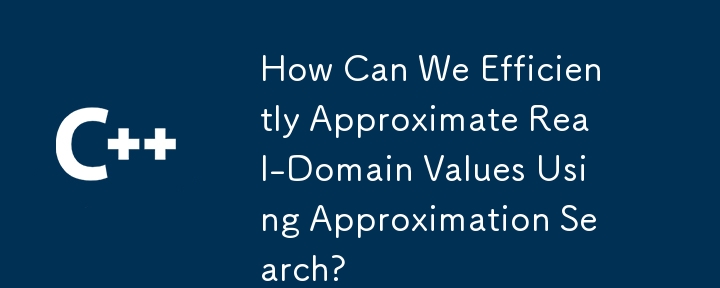 Backend Development
Backend Development
 C++
C++
 How Can We Efficiently Approximate Real-Domain Values Using Approximation Search?
How Can We Efficiently Approximate Real-Domain Values Using Approximation Search?
How Can We Efficiently Approximate Real-Domain Values Using Approximation Search?
Dec 27, 2024 am 04:18 AM
How Approximation Search Works
Prologue
This article aims to provide a comprehensive understanding of the inner workings of an approximation search class, designed to approximate values and parameters in the real domain for tasks such as polynomial fitting and equation solving.
Question
How can we approximate values or parameters in the real domain (using double-precision floating-point numbers) for tasks like fitting polynomials, finding parameters in parametric functions, or solving (difficult) equations (such as transcendentals)?
Restrictions
- Real domain (double-precision)
- C language
- Configurable precision of approximation
- Known interval for search
- Fitted value or parameter is not strictly monotonic or may not be a function at all
Approximation Search
Approximation search is analogous to binary search but removes the restriction that the searched function, value, or parameter must be a strictly monotonic function. Despite this relaxation, it maintains the same O(log(n)) complexity.
Algorithm
Consider the following problem:
Given a known function y = f(x) and a desired point y0, we aim to find x0 such that y0 = f(x0).
Known Information
- y = f(x) - input function
- y0 - desired point y value
- a0, a1 - solution x interval range
Unknown:
- x0 - target point x value within the range <a0, a1>
Algorithm Steps:
-
Probe points x(i) = <a0, a1> evenly spaced along the range with some step da.
- For example: x(i) = a0 i * da, where i = 0, 1, 2, ...
-
For each x(i), compute the distance/error ee between y = f(x(i)) and y0.
- This error can be calculated using metrics such as ee = fabs(f(x(i)) - y0).
- Remember the point aa = x(i) with the minimum distance/error ee.
- Stop when x(i) > a1.
-
Recursively increase accuracy.
-
Restrict the search range to the vicinity of the found solution:
- a0' = aa - da
- a1' = aa da
-
Enhance search precision by decreasing the search step:
- da' = 0.1 * da
- If da' is not excessively small or if the maximum recursion count has not been reached, return to step 1.
-
- The found solution is stored in aa.
Implementation in C
The provided C code demonstrates the implementation of the approximation search algorithm:
#include "approx.h"
int main() {
// Initialize the approx object with parameters
approx aa;
aa.init(0.0, 10.0, 0.1, 6, &ee);
// Loop until a solution is found
for (; !aa.done; aa.step()) {
// Retrieve current x
x = aa.a;
// Compute y
y = f(x);
// Compute error
ee = fabs(y - y0);
}
}The above is the detailed content of How Can We Efficiently Approximate Real-Domain Values Using Approximation Search?. For more information, please follow other related articles on the PHP Chinese website!

Hot Article

Hot tools Tags

Hot Article

Hot Article Tags

Notepad++7.3.1
Easy-to-use and free code editor

SublimeText3 Chinese version
Chinese version, very easy to use

Zend Studio 13.0.1
Powerful PHP integrated development environment

Dreamweaver CS6
Visual web development tools

SublimeText3 Mac version
God-level code editing software (SublimeText3)

Hot Topics
 What are the types of values returned by c language functions? What determines the return value?
Mar 03, 2025 pm 05:52 PM
What are the types of values returned by c language functions? What determines the return value?
Mar 03, 2025 pm 05:52 PM
What are the types of values returned by c language functions? What determines the return value?
 What are the definitions and calling rules of c language functions and what are the
Mar 03, 2025 pm 05:53 PM
What are the definitions and calling rules of c language functions and what are the
Mar 03, 2025 pm 05:53 PM
What are the definitions and calling rules of c language functions and what are the
 C language function format letter case conversion steps
Mar 03, 2025 pm 05:53 PM
C language function format letter case conversion steps
Mar 03, 2025 pm 05:53 PM
C language function format letter case conversion steps
 Where is the return value of the c language function stored in memory?
Mar 03, 2025 pm 05:51 PM
Where is the return value of the c language function stored in memory?
Mar 03, 2025 pm 05:51 PM
Where is the return value of the c language function stored in memory?
 How do I use algorithms from the STL (sort, find, transform, etc.) efficiently?
Mar 12, 2025 pm 04:52 PM
How do I use algorithms from the STL (sort, find, transform, etc.) efficiently?
Mar 12, 2025 pm 04:52 PM
How do I use algorithms from the STL (sort, find, transform, etc.) efficiently?
 How does the C Standard Template Library (STL) work?
Mar 12, 2025 pm 04:50 PM
How does the C Standard Template Library (STL) work?
Mar 12, 2025 pm 04:50 PM
How does the C Standard Template Library (STL) work?








